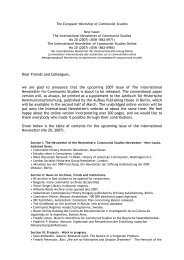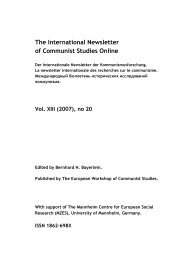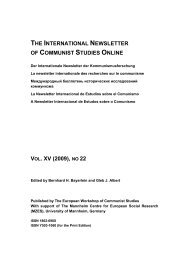The International Newsletter of Communist Studies Online IX
The International Newsletter of Communist Studies Online IX
The International Newsletter of Communist Studies Online IX
Create successful ePaper yourself
Turn your PDF publications into a flip-book with our unique Google optimized e-Paper software.
<strong>The</strong> <strong>International</strong> <strong>Newsletter</strong> <strong>of</strong> <strong>Communist</strong> <strong>Studies</strong> <strong>Online</strong> 16/2003 39<br />
However, the Mexican Conference organized in 1926 did not bring unity and finally the idea collapsed after the<br />
failure <strong>of</strong> the miners’ strike in Great Britain in the same year. Since that failure the Pr<strong>of</strong>intern leader Lozovsky<br />
developed the idea to form the Latin American Trade Union Confederation (CSLA) for the unification <strong>of</strong> all<br />
Moscow supporters in the region founding parallel structures throughout the whole continent. <strong>The</strong> creation<br />
finally occurred in 1929. But in most <strong>of</strong> the cases, this policy led to a disconnection with the existing workers’<br />
unions (many <strong>of</strong> the CSLA branches were mere re-editions <strong>of</strong> local communist parties). In some cases, the new<br />
Confederation proved able to organize some new groups <strong>of</strong> workers. <strong>The</strong> next important strategic change was<br />
the installation <strong>of</strong> the Popular Fronts policy in 1934/35 supported seriously by the trade union cadres and<br />
prepared during these previous years.<br />
Svetlana Rosenthal, RGASPI, Moscow, Russia: Latin America in the Comintern Archives<br />
<strong>The</strong> Russian State Archive <strong>of</strong> Social and Political History allowed researchers to access the Comintern<br />
documents stored there. Since the opening <strong>of</strong> the archive a lot <strong>of</strong> previously unknown documents were<br />
introduced into scholarly circulation and several thousands <strong>of</strong> documents were published in the thematic<br />
collections provided with a series <strong>of</strong> indices. Also a brief guide for the archive collections and registers was<br />
published. <strong>The</strong> scientific and reference apparatus <strong>of</strong> the Comintern archive is continually modernized and the<br />
process <strong>of</strong> computerization is very close to its accomplishment. Eventually, this shall make it easier in the<br />
search <strong>of</strong> necessary documents. <strong>The</strong> inflow <strong>of</strong> researchers to the archive does not stop, which shows the<br />
inexhaustible interest in Comintern history, including the interest in the history <strong>of</strong> the Latin American working-<br />
class movement. In the documents referring to Latin America there can be found 108 archive registers (from a<br />
total number <strong>of</strong> 527), while 25 registers are exclusively »Latin American«. Nowadays some themes present a<br />
great interest for study; one <strong>of</strong> these topics is the activity <strong>of</strong> the international revolutionary organizations such<br />
as the <strong>Communist</strong> Youth <strong>International</strong>, the Pr<strong>of</strong>intern, the <strong>International</strong> Workers Relief, the Krestintern, etc.,<br />
whose history has not been fully up until now. As these organizations worked legally, their activity was more<br />
various and versatile than the activity <strong>of</strong> the communist parties who in almost all <strong>of</strong> the countries <strong>of</strong> the<br />
continent functioned underground. Frequently these organizations served as a legal covering for the<br />
communists and their leadership was composed <strong>of</strong> communist party cadres. While today the OMS <strong>of</strong> the<br />
Comintern documents collection is still in confidential storage, the documents <strong>of</strong> the OMS <strong>of</strong> the Pr<strong>of</strong>intern<br />
were always accessible and they contain a lot <strong>of</strong> data about the cadres and the coordination <strong>of</strong> illegal<br />
connections with the national Pr<strong>of</strong>intern and Comintern sections. Latin American trade unions and their<br />
relations with Moscow are one <strong>of</strong> the most interesting areas <strong>of</strong> the world working class history. In the<br />
Pr<strong>of</strong>intern documentary collections one can find the documents written by D. Rivera, D. A. Siqueiros, V. R. Haya<br />
de la Torre, A. C. Sandino and other famous persons. Such subjects as the functioning <strong>of</strong> the Latin American<br />
Confederation <strong>of</strong> the Workers (CSLA) and the activity <strong>of</strong> Pr<strong>of</strong>intern representatives in Latin America are poorly














